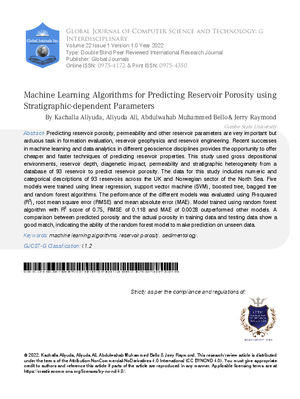Abstract
Predicting reservoir porosity permeability and other reservoir parameters are very important but arduous task in formation evaluation reservoir geophysics and reservoir engineering Recent successes in machine learning and data analytics in different geoscience disciplines provides the opportunity to offer cheaper and faster techniques of predicting reservoir properties This study used gross depositional environments reservoir depth diagenetic impact permeability and stratigraphic heterogeneity from a database of 93 reservoir to predict reservoir porosity The data for this study includes numeric and categorical descriptions of 93 reservoirs across the UK and Norwegian sector of the North Sea Five models were trained using linear regression support vector machine SVM boosted tree bagged tree and random forest algorithms The performance of the different models was evaluated using R-squared R2 root mean square error RMSE and mean absolute error MAE Model trained using random forest algorithm with R2 score of 0 75 RMSE of 0 118 and MAE of 0 0028 outperformed other models A comparison between predicted porosity and the actual porosity in training data and testing data show a good match indicating the ability of the random forest model to make prediction on unseen data The machine learning technique presented in this study represents a pragmatic approach to the classical log conversion problem that over the years has caused dilemmas to generations of geoscientists and petroleum engineers The method requires no underlying mathematical models or costly assumptions of linearity among variables Predicting porosity by using sedimentological parameters can effectively reduce the high cost of using petrophysical methods such as nuclear magnetic resonance and other logging methods
This work is licensed under a Creative Commons Attribution 4.0 International License.
Copyright (c) 2022 Authors and Global Journals Private Limited

